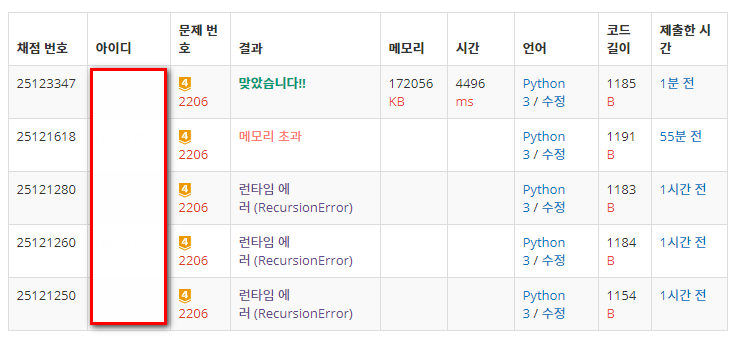https://www.acmicpc.net/problem/2206
시간 2초, 메모리 192MB
input :
- N M (1 <= N, M <= 1,000)
- 1, 0 으로 구성된 맵(1은 이동할 수 없는 벽, 0은 이동 가능)
- (1, 1), (N, M)은 항상 0
output :
- 최단 거리를 출력, 불가능 할 때는 -1을 출력.
조건 :
- 최단 경로는 시작하는 칸과 끝나는 칸도 포함해서 센다.
- 한 개의 벽을 부수고 이동하는 것이 더 경로가 짧아진다면, 한 개 까지는 부수고 이동하여도 된다.
- 이동 할 수 있는 칸은 상하좌우.
벽을 깬 것을 어떻게 해야 할까.
기저사례를 생각해보자.
- 벽을 2번 이상 깨야 하는 경우.
- 현재의 위치가 목적지일 떄 값을 저장.
칸을 한 칸 씩 이동할 때 마다 값을 저장 해놓을 값이 필요
목적지에선 최솟값을 비교해서 저장해야함.
현재 까지 이동한 거리를 기록하는 새로운 지도가 필요
import sys
sys.setrecursionlimit(1000000)
N, M = map(int, sys.stdin.readline().split())
graph = [[] for _ in range(N)]
dp = [[] for _ in range(N)]
result = 100000000
cnt = 1
for i in range(N):
data = sys.stdin.readline().strip()
for j in data:
graph[i].append(int(j))
dp[i].append(int(j))
def DFS(x, y, crash):
global result
global cnt
if x == N - 1 and y == M - 1:
result = min(result, cnt)
dx = [1, -1, 0, 0]
dy = [0, 0, -1, 1]
for i in range(len(dx)):
nx = x + dx[i]
ny = y + dy[i]
if nx >= N or nx < 0 or ny < 0 or ny >= M:
continue
if graph[nx][ny] == 1:
if crash:
continue
else:
crash += 1
cnt += 1
graph[x][y] = 2
DFS(nx, ny, crash)
graph[x][y] = dp[x][y]
cnt -= 1
crash -= 1
elif graph[nx][ny] == 0:
cnt += 1
graph[x][y] = 2
DFS(nx, ny, crash)
graph[x][y] = dp[x][y]
cnt -= 1
DFS(0, 0, 0)
if result == 100000000:
print(-1)
else:
print(result)DFS로 풀고 있었는데 메모리 초과가 발생한다... BFS 찾아보자.
dp로 그려놓는 메모리가 큰것 같다.
대부분 3차원 배열을 이용하는데. 어떤 여부를 저장해 놓으려는 경우에 자주 쓰는 것 같다.
벽을 뚫을 수 있는 능력 존재
존재 하지 않음 두 경우를 나눠서 저장 해놓는 배열이 있으니 매우 편하다.
import sys
from _collections import deque
N, M = map(int, sys.stdin.readline().split())
graph = [[] for _ in range(N)]
cache = [[[0] * 2 for _ in range(M)] for _ in range(N)]
for i in range(N):
data = sys.stdin.readline().strip()
for j in data:
graph[i].append(int(j))
def BFS():
q = deque([(0, 0, 1)])
cache[0][0][1] = 1
while q:
x, y, crash = q.popleft()
if x == N - 1 and y == M - 1:
return cache[N - 1][M - 1][crash]
dx = [1, -1, 0, 0]
dy = [0, 0, -1, 1]
for i in range(4):
nx = x + dx[i]
ny = y + dy[i]
if nx >= N or nx < 0 or ny >= M or ny < 0:
continue
if graph[nx][ny]:
if crash and not cache[nx][ny][crash - 1]:
cache[nx][ny][crash - 1] = cache[x][y][crash] + 1
q.append((nx, ny, crash - 1))
else:
continue
else:
if not cache[nx][ny][crash]:
cache[nx][ny][crash] = cache[x][y][crash] + 1
q.append((nx, ny, crash))
ret = BFS()
if ret:
print(ret)
else:
print(-1)
3차원 배열 잘 써먹어 보자
